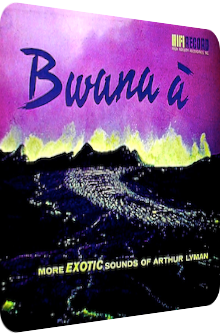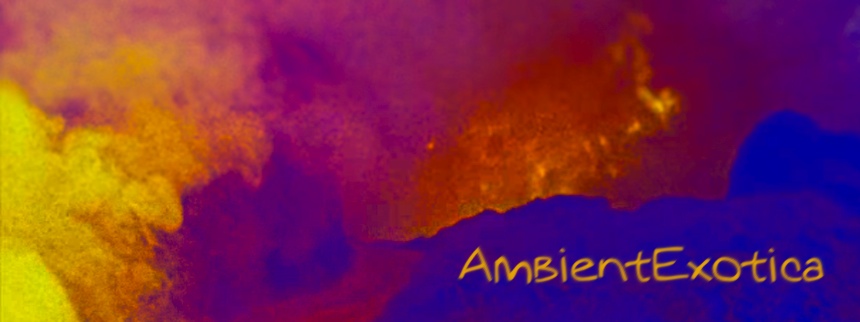
Arthur Lyman
Bwana A
1958
Following Arthur Lyman‘s real Exotica debut album Taboo of 1958, Bwana Ā is one of several albums that were released by Arthur Lyman and his bandmates in the following months which had to be created quickly in several night shifts. If this isn‘t an indicator for the sheer craving of a good middle-class escapist movement that wanted more exotic music incessantly, I don‘t know what it takes to prove it. As a matter of course, the band was one of the few whose output was awe-inspiring both in quantitative and qualitative terms.
The Arthur Lyman Group consisted of John Kramer, Alan Soares, Harold Chang and, obviously, Lyman himself. Additional help is provided by Ethel Azama, Paul Conrad of the Gene Rains Quartet and flutist Chew Hoon Chang. On Bwana Ā, the quartet offers an exotic mixture of traditional songs, original pieces by Lyman with collaborators and songs that were particularly written for Lyman and this album in mind. What makes this particular release so great in my book is the long duration and slow setup of most tracks, their relaxing atmosphere, the numerous downtempo offerings and a surprising variety of styles and instruments, be it live wire drums on the title song plus tribal chants or the ecstatic vividness of the moon harp on Canton Rose.
While Lyman‘s vibraphone is audible on every piece, I applaud the fact that his mallet instrument isn‘t the cornerstone or focus, but just another instrument that isn‘t integrated due to Lyman‘s good name and his undeniable skills but because of the aura that is about to be created by each respective track. According to the liner notes, all of the tracks have an important meaning for the band, but stuff like this turns up on most liner notes anyway, so I‘m not too blinded by the given information. I will review the majority of Bwana Ā, and since this album is one of my very favorites by Lyman and is furthermore – probably paradoxically – coherent and diversified, be prepared for excessive catchwords and rose-tinted indulgence. I‘m sorry in advance!
Bwana Ā is the title track – meaning "boss friend" and dedicated by Lyman and Kramer to their friend Henry J. Kaiser – and starts with a blast by introducing pressing drums and glinting sounds of Lyman‘s vibes. A male chanter is accompanied by a choir – among the singers is Ethel Azama –, a noveltyum in a Lyman song, but the sudden inclusion of bird noises make clear that Lyman hasn‘t changed the remaining ingredients of the formula. The song is the most tribal and ethnic one with gentle rattles, and Kramer‘s slightly cacophonous flute melodies work well in the surrounding. Lyman‘s vibes are reduced in this setup which amplifies the impression of a tribal dance. The tempo shift is also cleverly executed, and when it occurs, the drums and percussions are the real stars. The plasticity of the song is mind-blowing and while it isn‘t overly melodious, it is a strong offering if you prefer faux-tribal elements in your Exotica music.
South Pacific Moonlight was specifically composed by David Kupele for this album. It starts with instrumental imitations of a ship‘s bell of a steamer and gentle ocean waves, all the while Lyman is playing a soothingly quiescent melody on the vibes and is accompanied by Chang who provides very lush drums. This is one of those tracks that transports Lyman‘s trademark of a more quiet and reduced but still melodious use of his vibes. Sure enough, it sounds rather boring after the energetic Bwana Ā, but it is a charming song for quieter nights. Moon Over A Ruined Castle is a traditional song from Japan and continues the moonlight theme with coruscating wind chimes, fragile finger cymbals and Lyman‘s reverberating vibraphone. The ghostly piano melody is a strong addition as is the inclusion of a cheeky marimba melody. A chinese gong closes the song, and while it contains clichéd ingredients, the majestic nature of this old traditional song with its quirky melodies is perfectly preserved.
Waikiki Serenade is one of the few distinctly Latin songs despite its title. The tremoling piano plays with slight hints of melancholy before the songs morphs into a noisy bossa nova peace that is more joyful. The feeling is surprisingly Latin, making Waikiki Serenade one of the rare Lyman tracks where that feeling is presented in a thoroughly honest style without an exuberantly tropical alteration with the help of the vibes, as it is done numerous times on Bahia, released in 1959. Coming up next is Sebastián de Yradier‘s world-famous classic La Paloma, probably the most well-known rendition on the album. The main melody is adopted by quavering vibes while Soares‘s piano backings are almost primitive and overly reduced – I would have liked some kind of improvisation or a short-term counterpoint, as this version remains too streamlined.
The Japanese Otome San, however, eradicates my previous thoughts and is the most playful tune: Cascading vibraphone notes, vibrating piano chords and hand claps mark the beginning, before a typically filial melody clarifies the song‘s function as a drinking song. This song couldn‘t be farther away from the pompous setting of the Bwana Ā song, but isn‘t incongruous in the end, especially note on side A, where Moon Over A Ruined Castle displays a different Japanese setting.
Canton Rose starts as a mystical ode and features Chew Hoon Chang on the bamboo flute and moon harp, the latter instrument being a highlight with its clean and exotic sound. The tempo increases and the hectical marimba accompaniment lets you almost forget about the mellow beginning. Here we have the rare case in my opinion, that the specific sound of the moon harp is stronger and more important than the actual melodies. The following Malaguena is completely transformed by Lyman. While its rustic piano melodies are still recognizable, the gently played acoustic guitar and the sparkling xylophones make this an interesting version whose drama is amplified in the last third with loud crescendos of dark pianos.
Coming up next is one of my most favorite Lyman renditions ever: the theme of the shocking Western movie Vera Cruz. It starts with a surprisingly modern sustained cymbal, melancholic piano notes, muffled drums and the resurfacing of various masterful bird noises which add an important contrast to the lamenting feeling of the first half. Lyman exchanges his vibes for a marimba on here, the instrument's sound being more befitting. The second half is basically the same, but the piano notes are more majestic and convivial. I like this song very much due to its conflictive nature: on the one hand we have pure melancholy and slight hints of tragedy made audible on the piano, and on the other hand there is the most welcome inclusion of bird noises which give the song a conciliatory flavor. This is definitely the darkest and weirdest song on Bwana Ā, and is absolutely beautiful due to its simultaneous oscillation between the different moods.
Pua Carnation is a simple ballad with the unexpected addition of a barely noticeable Hammond organ which plays the backing melody to Lyman‘s dominant but dreamy vibraphones. What is otherwise a Lyman song by the numbers gets more interesting due to the organ. An interplay that is as unusual as it is successful. The closing Colonel Bogey March is a tropical rendition of a popular march that many contemporary listeners of the album have encountered in the form of The Bridge On The River Kwai, where it was blatantly featured. I‘m no fan of military marches to be honest, but the playful, cheeky atmosphere dampens the military nature and the main melody on vibes is highly extraordinary. In the end, you cannot take this song seriously, which is my main problem: after the huge Vera Cruz and the soothing Pua Carnation, this is definitely the worst way to end an otherwise gorgeous album. However, if you see Bwana Ā as a simple collection of various songs rather than a dead serious concept album, you won‘t care at all, and I know that I shouldn‘t either.
Bwana Ā is a strong album, back then as well as today. Arthur Lyman‘s tropical style was highly sought after and wasn‘t worn thin in the slightest. The inclusion of well-known classics as well as traditional songs and entirely new material has proven to be successful. From the tribal chants of the title track over the moon-lit scintillas to the standard vibe ballads goes the journey, and the melange of styles and instruments is always refreshingly vivid. The mood in the Henry J. Kaiser Aluminum Dome must have been fantastic and was without a doubt driven by the success of the band‘s debut Leis Of Jazz. The album furthermore propitiates the divided legions of Exotica fans: audiophile listeners who ponder about the technical achievements by the band and the sound quality are as happy with the result as afficionados who care about the moods, settings and melodies first.
Bwana Ā caters supporters of both camps. In contrast to Bahia, it is definitely more laid back and mellow, while Bahia consists of Latin classics and is Lyman‘s most energetic album ever. I don‘t hope you have to decide between the two, as the decision would be very hard. Fortunately, you don‘t have to make that choice if you‘re new to the Lyman game, as both albums are coupled on one CD. Better still, if you want to make a real bargain, go for the Ultimate Collection on iTunes which costs just less than 6 bucks at time of writing and features a whopping 82 songs, among them the full Bwana Ā album in terrific quality. If there ever was a bargain, this would be the one. Apart from any compilations and prices, Bwana Ā is a masterpiece with an astonishingly eclectical variety of styles. This is no simple Easy Listening album, but an illustrious offering by one of Exotica‘s biggest names.
Exotica Review 036: Arthur Lyman – Bwana Ā (1959). Originally published on Feb. 18, 2012 at AmbientExotica.com.
